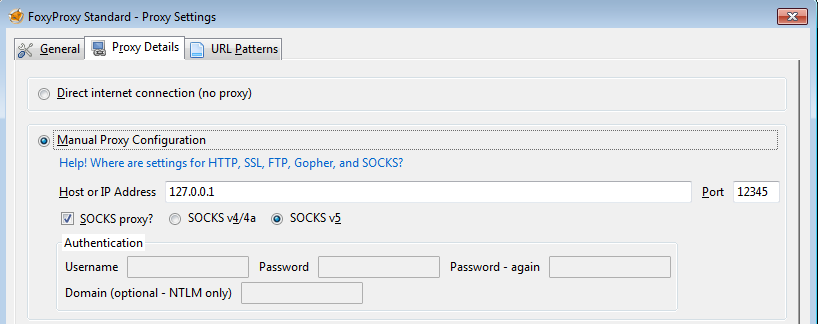To use your own server as a proxy: You have a couple options.
Easiest way: plink
Using your SSH server as a SOCKS proxy using port forwarding in PLINK.
- Have plink ready and create a shortcut like this:
plink USER@HOST -pw PASSWORD -C -T -D 127.0.0.1:PORTNUMBER -N - Change
USERwith your real username,HOSTwith your IP address,PASSWORDwith password you need,PORTNUBMERwith a port number you want. - Start the shortcut and your SOCKS proxy is now ready.
You can check explanation of each parameter here
If you are using FoxyProxy Free version, you can create a new proxy using these settings below (assuming you set port on 12345):

Other options
PuTTY
Using your SSH server as a SOCKS proxy using port forwarding in PuTTY.
Only problem with this option is you have to keep PuTTY open as long as you want to proxy, is there an alternative? Well… there is this (very long setup and requires many programs) and this (looks easy, haven’t tested it though, uses plink, not open source).
Squid3
Using Squid3 as an HTTP proxy (and a SSL proxy if you build it with SSL support) (using with or without FoxyProxy). There is this tutorial (which I could not make it work), so good luck with that.
I tried to configure Squid3 to use it as a HTTP proxy but I could not do it. (Too many damn directives)
Squid3 tips
- There is no
https_accessdirective, onlyhttp_accessbut there ishttps_port. - SSL won’t work because
http_access deny CONNECT !SSL_portsin the default configuration file blocks it.
FoxyProxy Plus
Because free version of FoxyProxy (poor man’s FoxyProxy) doesn’t support authentication on SOCKS proxies, you can use FoxyProxy Plus ($20) to use your server as a SOCKS proxy with authentication (no port forwarding)
I don’t recommend this option.
Comments
Show comments this time only or Show comments for next 7 days